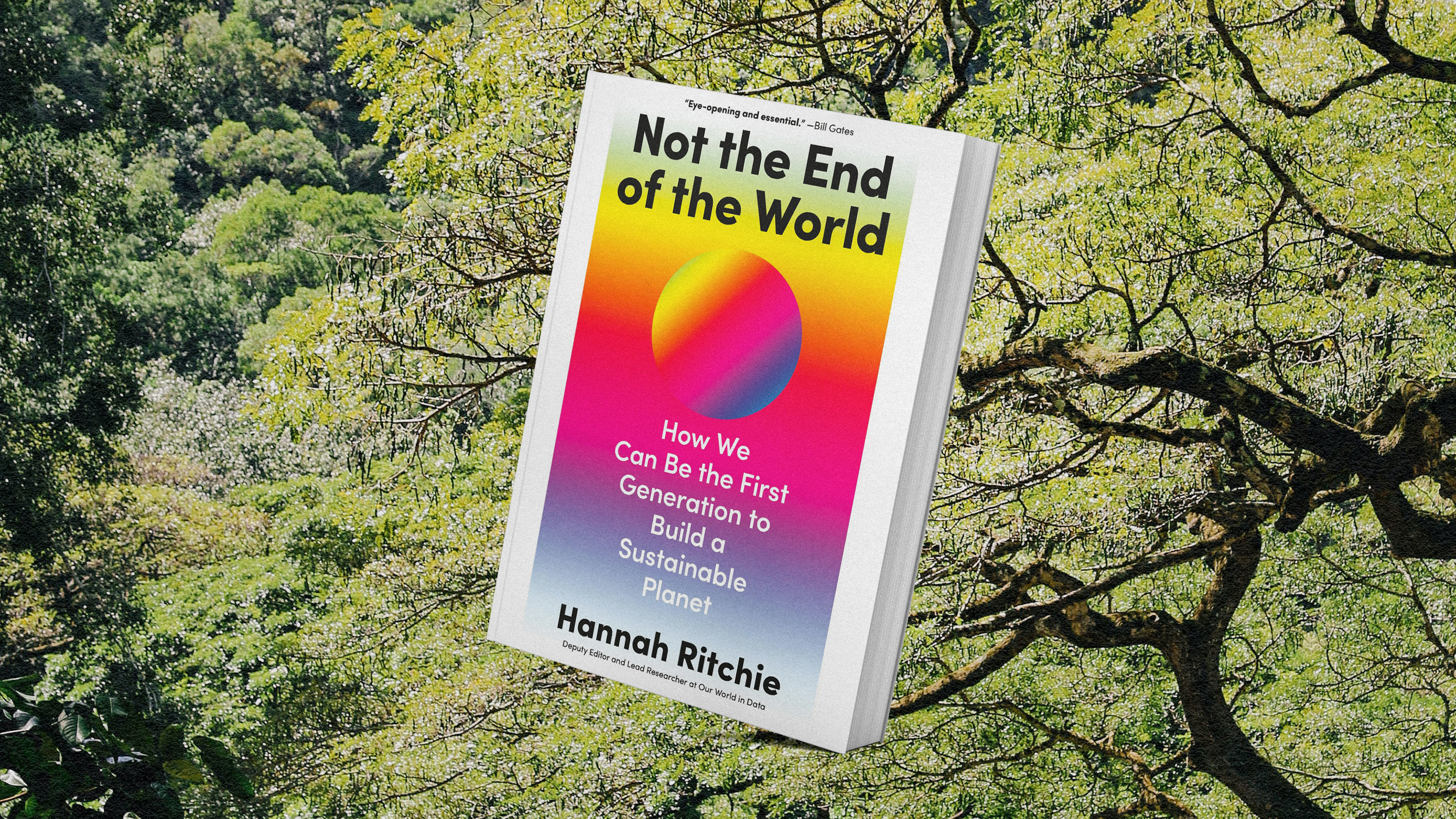More people care about climate change than you think

People across the world, and the political spectrum, underestimate levels of support for climate action.
This “perception gap” matters. Governments will change policy if they think they have strong public backing. Companies need to know that consumers want to see low-carbon products and changes in business practices. We’re all more likely to make changes if we think others will do the same.
If governments, companies, innovators, and our neighbors know that most people are worried about the climate and want to see change, they’ll be more willing to drive it.
On the flip side, if we systematically underestimate widespread support, we’ll keep quiet for fear of “rocking the boat”.
This matters not only within each country but also in how we cooperate internationally. No country can solve climate change on its own. If we think that people in other countries don’t care and won’t act, we’re more likely to sit back as we consider our efforts hopeless.
Support for climate action is high across the world
The majority of people in every country in the world worry about climate change and support policies to tackle it. We can see this in the survey data shown on the map.
Surveys can produce unreliable — even conflicting — results depending on the population sample, what questions are asked, and the framing, so I’ve looked at several reputable sources to see how they compare. While the figures vary a bit depending on the specific question asked, the results are pretty consistent.
In a recent paper published in Science Advances, Madalina Vlasceanu and colleagues surveyed 59,000 people across 63 countries.1 “Belief” in climate change was 86%. Here, “belief” was measured based on answers to questions about whether action was necessary to avoid a global catastrophe, whether humans were causing climate change, whether it was a serious threat to humanity, and whether it was a global emergency.
People think climate change is a serious threat, and humans are the cause. Concern was high across countries: even in the country with the lowest agreement, 73% agreed.
You can see the differences in this score across countries in the map below.
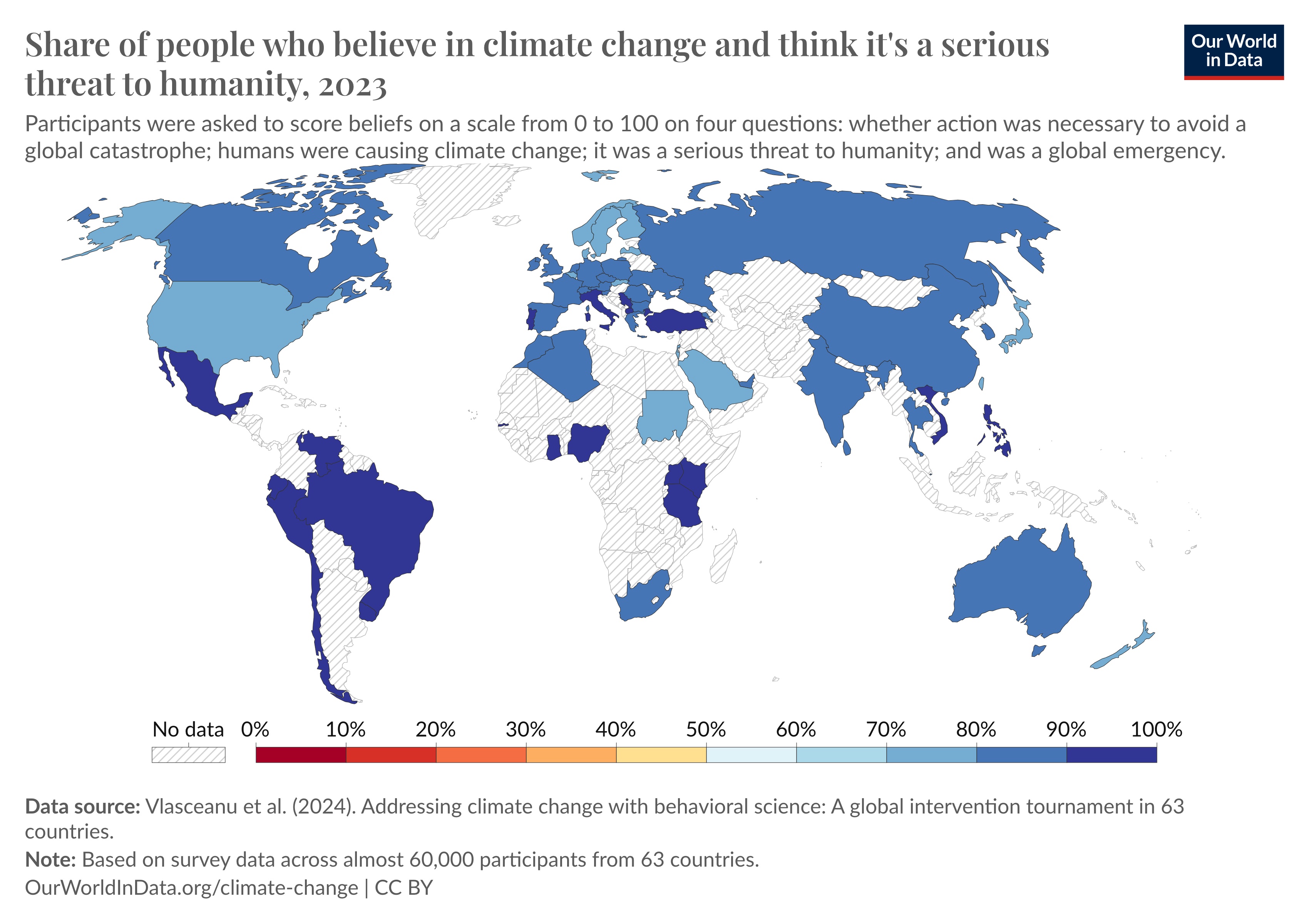
The majority also supported climate policies, with an average global score of 72%. “Policy support” was measured as the average across nine interventions, including carbon taxes on fossil fuels, expanding public transport, more renewable energy, more electric car chargers, taxes on airlines, and protecting forests. In the country with the lowest support, there was still a majority (59%) who supported these policies.
These scores are high considering the wide range of policies suggested.
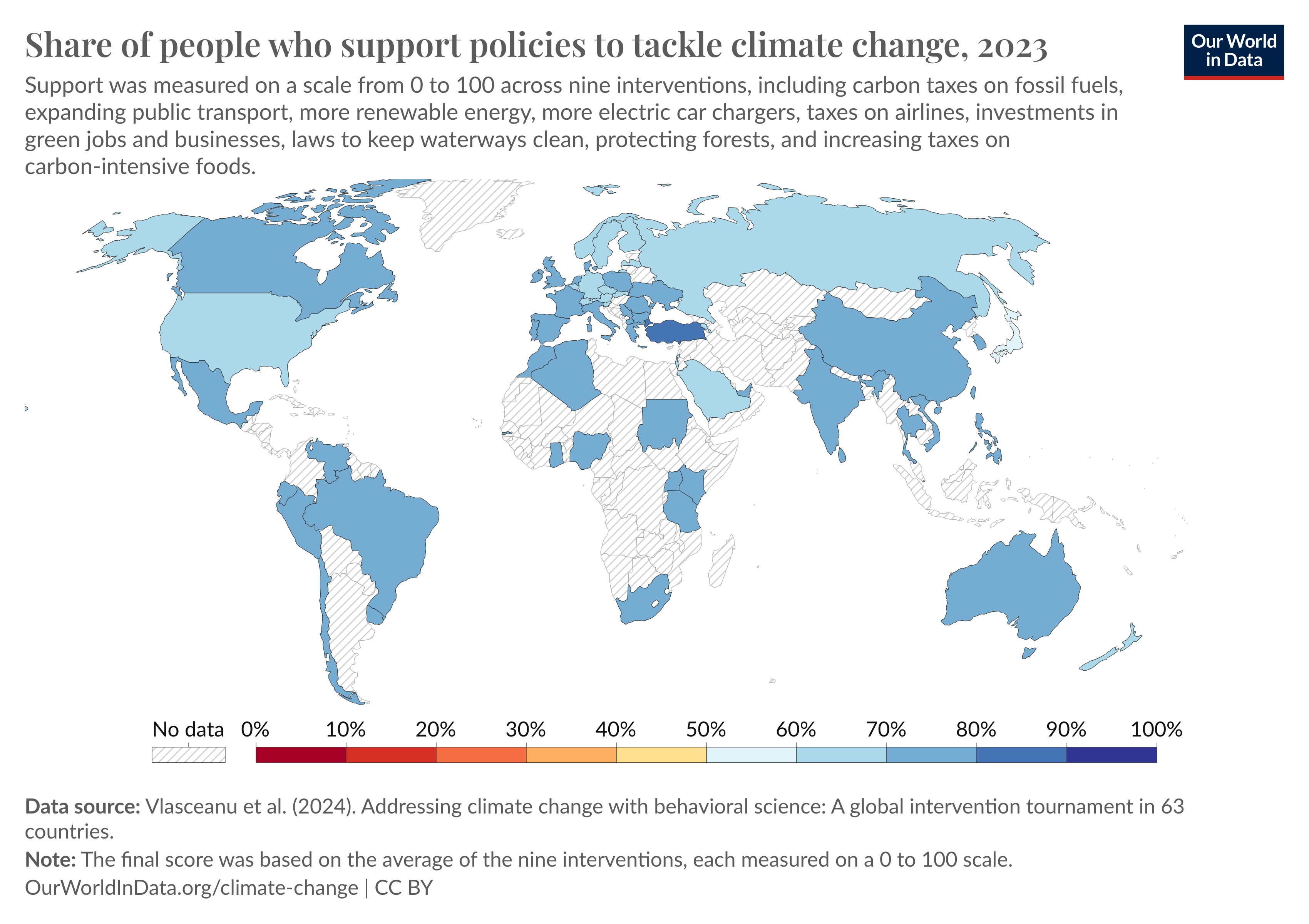
Another recent paper published in Nature Climate Change found similarly high support for political change. Peter Andre et al. (2024) surveyed almost 130,000 individuals across 125 countries.2
89% wanted to see more political action. 86% think people in their country “should try to fight global warming” (explore the data). And 69% said they would be willing to contribute at least 1% of their income to tackle climate change. We’ll look at this “willingness to pay” later.
Support for political action was strong across the world, as shown on the map below.
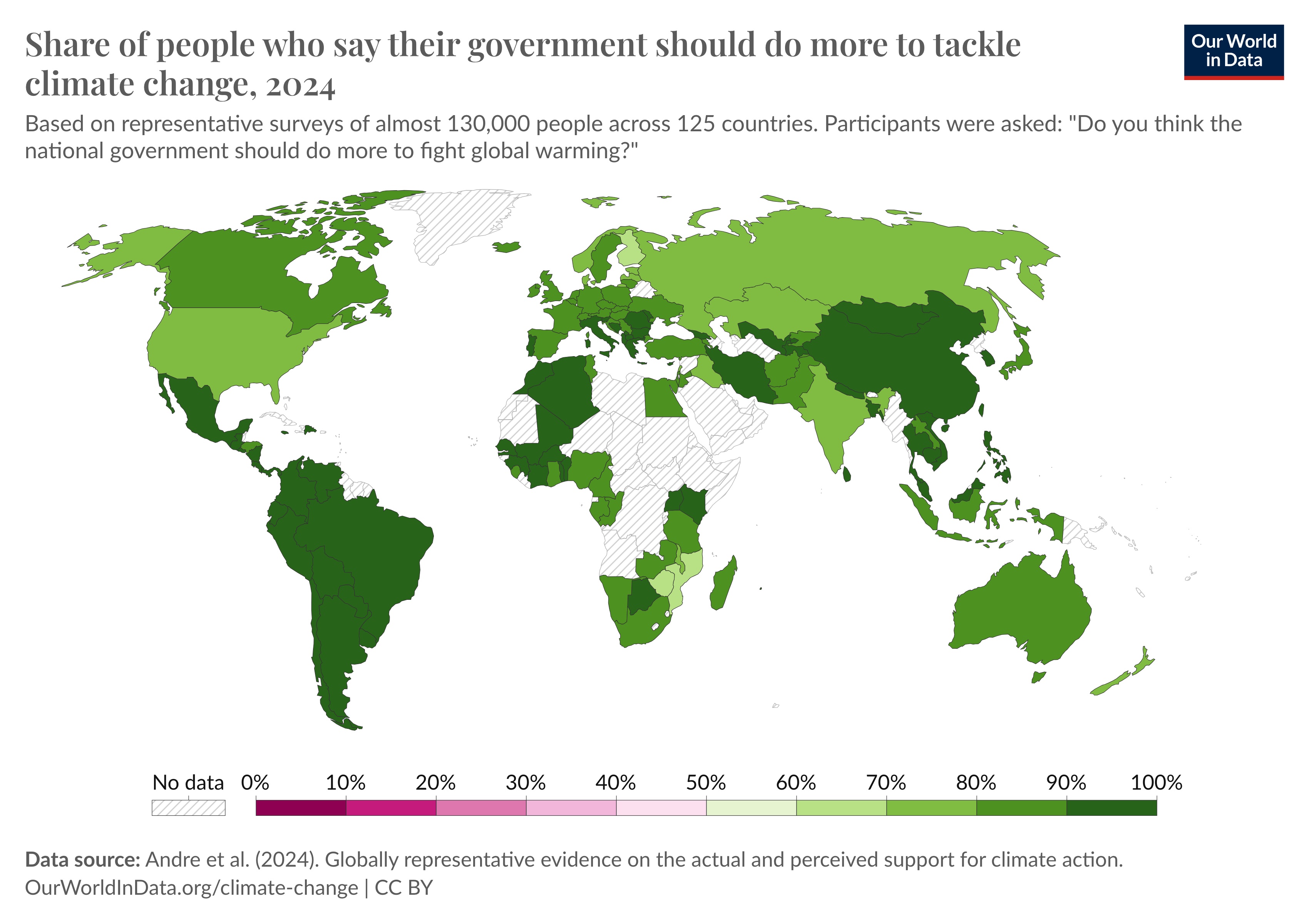
To ensure these results weren’t outliers, I looked at several other studies in the United States and the United Kingdom.
70% to 83% of Americans answered “yes” to a range of surveys focused on whether humans were causing climate change, whether it was a concern, and a threat to humanity. In the UK, the share who agreed was between 73% and 90%. I’ve left details of these surveys in the footnote.3
The fact that the majority of people “believe” in climate change and think it’s a problem is consistent across studies.
Most people underestimate popular support for climate action
Most of us systematically underestimate how widespread support for climate action is.
We see evidence for this in the study by Andre et al. (2024) we already looked at. It asked people if they’d be willing to give 1% of their income to tackle climate change. Across the 125-country sample, 69% said “yes”.
They then asked the same participants what share of others in their country would say “yes” to the same question. The average across countries was just 43%.
This wasn’t just the case in some countries; it was the case in every country. You can see this in the chart below. On the horizontal axis, we have the share that said they were willing to give 1% of their income. On the vertical axis is the perceived share of how many would be willing to give. Every single country falls below the “equity” line, meaning that the share was underestimated everywhere.
More people in our country care about this issue than we think.
One interesting observation is that populations in low- and middle-income countries are more willing to pay than in rich countries. 83% of those in Bangladesh said yes, compared to 48% in the UK or the US. This might reflect levels of climate risk: if your livelihood was at risk from climate-related disasters, then you are more willing to give up some of your income. This feeling of threat might be less salient in richer, more temperate countries.
We should always be cautious when examining people’s claims that they are willing to pay. Saying you’ll give up some of your income is not the same as actually doing it. Nonetheless, these results tell us that there is a “perception gap” in how we view our own climate opinions and those of others.
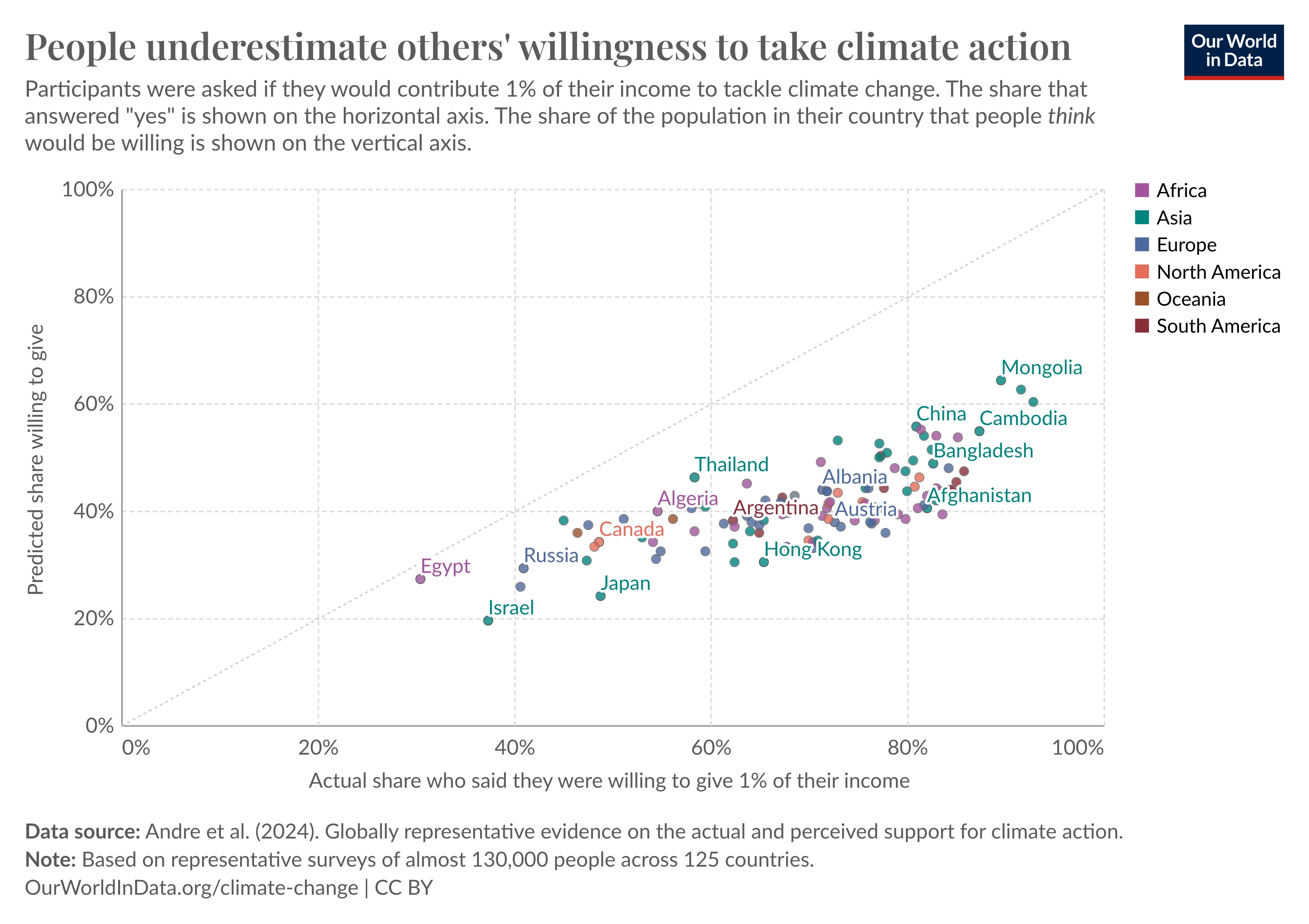
Other studies document the same. A study published in Nature Communications found that 80% to 90% of Americans underestimated public support for climate policies.4 And not by a small amount: they thought that just 37% to 43% were supporters, despite the actual number being 66% to 80%. In other words, they thought people in favor of climate policies were in the minority. In reality, the opposite was true: more than two-thirds of the country wants to see more action.
Another study found the same underestimation in both the US and China. This was true across the general public, but also the “intellectual elites” and “public elites”: key decision-makers and communicators also think climate support is much lower than it is.
It even holds true when you focus on Republican voters in the US. In most countries in the world, there is a “partisan gap” on climate change: those on the political left tend to think it is a higher priority than those on the political right. But this gap is often smaller than people think: in most countries, there is still majority support for action among supporters of right-wing parties.5
The “partisan gap” in the US is bigger than elsewhere. But, again, it’s smaller than people think — especially Republican voters themselves. A study published in Nature Communications found that Republicans consistently underestimated levels of support for a range of climate policies among their fellow voters.6 This misperception was strongest among Republican voters who opposed climate policies. They falsely assumed that most other Republicans held the same views as them.
Why does this “perception gap” exist?
This “perception gap” isn’t limited to climate change. It’s well-documented across a range of measures. On Our World in Data, we have previously documented the “happiness gap”: in every country, people underestimate how happy others are with their lives.
The perception gap might be partly explained by the fact that people tend to be positive about themselves, but negative about other people they don’t know. This is often referred to as “individual optimism and societal pessimism”.7 As one survey organization puts it:
“Societal pessimism describes the concern that society is in decline and heading in the wrong direction. Interestingly, a rather substantial quantity of people think that their country is not doing well overall, while still being generally quite satisfied with and hopeful about their own lives.”
How does this relate to climate change? We might be individual optimists about our ability to trust and reason with evidence, and support policies that protect us and future generations, but be pessimistic that others do the same.
There are other explanations for why this perception gap exists.
Social media probably plays some role. On social media, extreme opinions are amplified.8 We might hear more voices that are extremely opposed to climate action, while we hear very little from the average voter who supports it.
Mainstream media has influence too. Polarizing stories make better headlines. “Most people support climate action” isn’t an exciting story.9 You’ll get more clicks by making people angry at others for disagreeing.
“Both sides” debates, for example in talk shows, can also give people the impression that they accurately reflect balance among the public. People think that far more people are opposed to climate action as a result.
The debate is now about the merits of different solutions, not whether we should act
For decades, the world debated whether climate change was happening, if humans were causing it, and if we should do something.
If you look at levels of concern in the UK since the millennium, for example, you find an interesting decline-then-rise. In the first decade of the 2000s, environmental concerns were very high. In 2005/06, 82% of Brits said they were concerned about “global warming”. This was around the time that Al Gore’s film An Inconvenient Truth was released. The Stern Report on the impacts and economics of climate change was published. And not far ahead of the release of the UK’s Climate Change Act. However, in the early 2010s, concern dropped dramatically, falling to just 60%. This might have resulted from the financial crisis, and other problems taking center stage. Climate change fell off the agenda. But since then, concern has rebounded, and is now back to record levels.
In the last decade, the conversation has moved on from “Is climate change happening?”. Most people in the world are convinced and concerned, and want to see strong and urgent action.
This fact is a victory for climate scientists. It’s hard to attribute this outcome to specific drivers, but the relentless work of climate scientists to gather and present evidence, climate activism (which can take many forms), and the increasingly visible ways that climate change is showing up in people’s lives have all played a role in gaining public attention. In the same survey in the UK, the share saying that “we are already feeling the effects of climate change” increased from 41% in 2010 to 73% in 2019.
The new debate, then, is what we should do. That will require a different focus for communication.
The OECD surveyed 40,000 people across 20 countries to understand their attitudes to climate policies. It found three key predictors of support: the perceived distributional impacts of policies (including whether the individual would be worse off); their perceived effectiveness in reducing emissions; and how progressive the policies were (support dropped if people thought policies would hit the poorest hardest).
The OECD had three treatment conditions. One group was shown a video about the impacts of climate change. A second group was shown a video about the impacts of specific climate policies. The third group was shown both videos. The survey measured their levels of support for specific policies before and after the videos were shown. The video showing the impacts of climate change was the least successful in increasing support. Informing people about the specifics of the policy performed much better. And the best result came from showing people both.
This makes sense. If someone is skeptical of the costs of renewable energy, the carbon footprint of an electric car compared to a petrol one, or whether heat pumps work, talking only about rising temperatures is not going to shift their position. To do that, we need to engage with their legitimate concerns about the effectiveness and possible negative impacts of these changes. We need to communicate what these changes mean — or don’t mean — for their individual lives, community, energy prices, or income. We need to explain the potential trade-offs and talk about the benefits.
This is crucial. A massive study of nearly 60,000 people across 23 countries on climate messaging found, again, that there was very strong support for political action.5 However, the support for specific policies was much more varied. Importantly, the framings of specific interventions mattered a lot. Policies built around “clean energy”, for example, got very strong support on both the left and the right. Negative framings such as “phasing out” or “ending” practices were much more polarizing.
The problem is that we often don’t get into specifics of solutions because we think we still have to convince people that climate change is a problem.
As researchers concerned about climate change, we still need to discuss its damaging impacts. But we need to shift much of the conversation towards solutions — what they are, how effective they are, what the benefits might be. That is the current roadblock to reducing emissions, not the recognition that we need to do so. The majority — in all countries — agree.
Republished under a Creative Commons BY license from Our World In Data. Read the original article.

